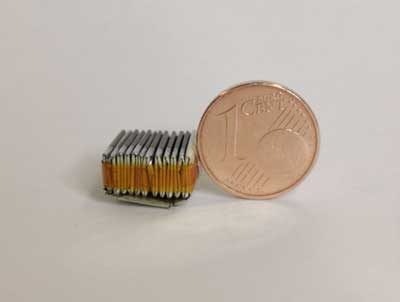| Feb 05, 2021 |
Inexpensive, printed thermoelectric generators for power generation
(Nanowerk News) Thermoelectric generators, TEGs for short, convert ambient heat into electrical power. They enable maintenance-free, environmentally friendly, and autonomous power supply of the continuously growing number of sensors and devices for the Internet of Things (IoT) and recovery of waste heat.
|
|
Scientists of Karlsruhe Institute of Technology have now developed three-dimensional component architectures based on novel, printable thermoelectric materials. This might be a milestone on the way towards use of inexpensive TEGs.
|
|
The results are reported in npj Flexible Electronics ("Fully printed origami thermoelectric generators for energy-harvesting") and ACS Energy Letters ("Shape-Versatile 3D Thermoelectric Generators by Additive Manufacturing").
|
 |
| With the help of newly developed inks and special production techniques, such as origami, inexpensive thermoelectric generators can be produced for various applications. (Image: Andres Rösch)
|
|
“Thermoelectric generators directly convert thermal into electrical energy. This technology enables operation of autonomous sensors for the Internet of Things or in wearables, such as smart watches, fitness trackers, or digital glasses without batteries,” says Professor Uli Lemmer, Head of the Light Technology Institute (LTI) of KIT. In addition, they might be used for the recovery of waste heat in industry and heating systems or in the geothermal energy sector.
|
New Printing Processes Thanks to Customized Inks
|
|
“Conventional TEGs have to be assembled from individual components using relatively complex manufacturing methods,” Lemmer says. “To avoid this, we studied novel printable materials and developed two innovative processes and inks based on organic as well as on inorganic nanoparticles.” These processes and inks can be used to produce inexpensive, three-dimensional printed TEGs.
|
|
The first process uses screen printing to apply a 2D pattern onto an ultrathin flexible substrate foil using thermoelectric printing inks. Then, a generator having about the size of a sugar cube is folded by means of an origami technique. This method has been developed jointly by KIT researchers, the Heidelberg Innovation Lab, and a spinoff of KIT. The second process consists in printing a 3D scaffold, to the surfaces of which the thermoelectric ink is applied.
|
Cost Reduction by Printing Technologies
|
|
Lemmer is convinced that scalable production processes, such as roll-to-roll screen printing or modern additive manufacturing (3D printing) are key technologies. “The new production processes not only enable inexpensive scalable production of these TEGs. Printing technologies also allow the component to be adapted to the applications. We are now working on commercializing the printed thermoelectrical system.
|

